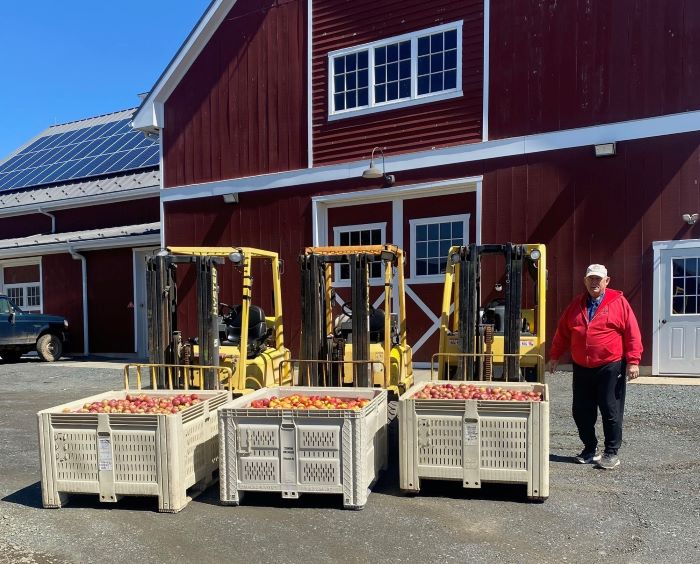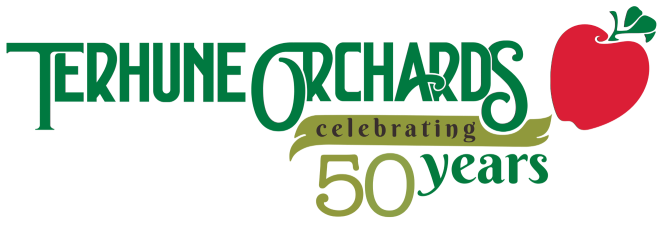by Gary Mount
 If visitors to Terhune Orchards see me, the farmer, I am most often driving a forklift, one of the most indispensable machines on the farm which is true of all fruit farms. That’s why you see three of them here —soon (we hope) to be four.
If visitors to Terhune Orchards see me, the farmer, I am most often driving a forklift, one of the most indispensable machines on the farm which is true of all fruit farms. That’s why you see three of them here —soon (we hope) to be four.
Forklifts, forklifts everywhere was not always the case. I grew up on an apple farm in Princeton–300 plus acres. That’s a lot of apples! When I first became aware of how my father’s farm operated, all apples were put into boxes–from picking to storing to sorting to sales–all wooden boxes. On that farm, that meant nearly 100,000 boxes—each one holding about one bushel or 42 pounds. I remember them well because it was the farmer’s sons who had the job of fixing broken boxes and my brother Lee and I were paid 5 cents each.
There was an army of men working on the farm just to handle the boxes of apples. At picking time a crew of men would “box out” the trees to be picked. They estimated how many were needed for each tree (I still can’t do it accurately) and the picker with a picking bucket hanging over his shoulder, would gently transfer the picked apples into the field box.
The job of picking apples is tough work. First picking the bottom of the tree, pickers then use a ladder to pick the top. Apples must be picked gently to avoid bruising and the picking bucket holds slightly more than a bushel – very heavy. Apple pickers were paid “by the piece” which means the amount of their pay was according to the quantity picked. Even keeping in mind that the apples had to be bruise free, good pickers were often the highest paid workers on the farm.
The pride of the pickers in doing a good job did not allow for any boxes to be partially filled; usually they were overfull. This brought another crew of men to the orchard to “cut them down” As
apple boxes were moved and stacked, any apples protruding above the top edge would be bruised by another box being stacked on top. Even worse, the rest of the apples in the lower box, all the way to the bottom, would get bruised. Bruising, if you don’t know, makes an apple unsaleable. All the work of growing and harvesting just ends up with a low value cider apple.
Handling all those boxes was time consuming and expensive. Picked apples were stacked on tractor drawn wagon, unstacked at the packing house, and moved to the sorting area or cold storage where they were stacked again by hand, sometimes 12 to 14 feet high.
It was a big day when my father purchased a forklift. It wasn’t new nor in the best repair, but oh my, having a forklift changed everything. I think I was around 11 years old when I started driving the forklift which would not be approved by today’s labor regulators but then maybe it wasn’t back then either. Boxes were stacked on pallets right from the orchard and stacking and moving by hand was over. My father and uncle had planted another orchard of 90 acres and never would they have been able to manage the increased crop without a forklift.
Operating a forklift was great. The right hand took care of operating the lifting and tilting of the load; the left hand steered. A large flat steering wheel had a “neckers knob” attached to make the steering easier. (Still not that easy with no power steering). For those of you who don’t know, a neckers knob, also known as a suicide knob, was sometimes attached to a car’s steering wheel in the days before power steering. It helped the driver steer while leaving the other arm free to provide romantic attention to a companion.
I kept driving and kept growing. On weekdays after school and on Saturdays it was hard to get me off the seat. After a few years. Apples were picked into 20-bushel bins and forklifts moved and stacked the bins. It was a big change in the fruit growing business and also made big changes in this driver as he grew up.
I remember a visit with my mother to Princeton Clothing on Witherspoon Street in Princeton for a new sport coat. As the mother of four growing boys, she was always warmly welcomed. Store owner, Ben Brown, had me try on coat after coat. None fit correctly. My left, forklift steering, arm and shoulder had become bigger than my right. Fortunately, men’s clothing stores in those days had tailors to do alterations. All was well.
Years later, after college and after serving in the Peace Corps. Pam and I bought Terhune Orchards. Our determination to be farmers and succeed in fruit growing had led us to disregard the fact that the previous owner had never modernized any aspect of Terhune’s. It was back to bushel boxes. Harvest time meant box them out, cut them down, stack on the trailer, unstack, move apples into the storage and stack again. Our storage was in the basement of the present farmstore where apples were sorted and from a platform there, bushels of apples were lifted overhead to a trap door in the sorting room floor. Tough work. Pam and Nancy Pillon, a terrific high school girl working for us then, were the only women who ever did this hard job.
I quickly learned why my father had been slow to get a forklift- they are expensive. For the first few years after purchasing the farm, we had no money for a forklift. But after a few years I bought a Hyster forklift. It was not new , not in good condition, and was actually the same make and model as my father’s. I wonder now , did I not realize that over the 20 years since my boyhood on the farm there would have been improvements? I suppose it was less expensive because of its age but one aspect was for sure, I could not tolerate a make of forklift other than Hyster. Just as farmers are particular about their green (John Deere) or red (International) or orange (Kubota) tractors, forklift users are particular about their make. I later bought 2 more Hysters, old and in poor repair and after a near disastrous accident on an old forklift, I bought a new one- Hyster of course!
The preference to brand does not only apply to users but also to the makers. I am told that after the Hyster company bought the Yale forklift company–a competing brand– both makes are made in the same factory. Halfway through the factory there is a wall. The assembly line splits. Hysters go one way and Yales the other. It is said that the factory workers building Hysters and Yales never speak to each other.
With good reason I would say; Yales are lousy. At Terhune, we now have three forklifts. The Hyster colors are as we like it- yellow and black.
